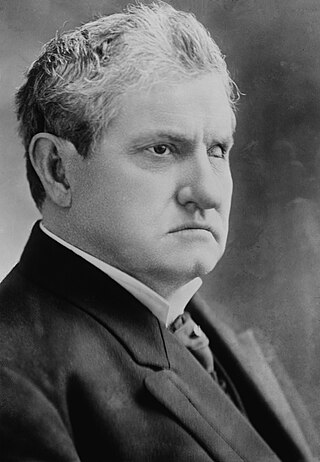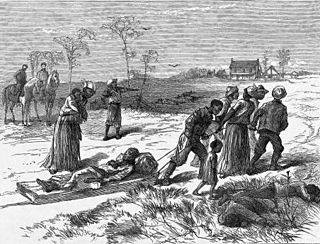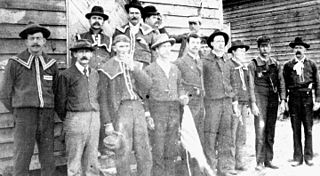Massacre
In September 1876, disturbances started near the hamlet of Silverton, in Aiken County. On September 15, Mrs. Alonzo Harley said two black men tried to attack her while her husband was working in the fields, but she grabbed her gun and drove them away. White citizens tracked down a man, Peter Williams, who was taken to the Hartleys for identification. When he tried to get away he was shot, but when Mrs. Hartley saw him, she said he was not the man who attacked her. Williams died of his wounds about a week later. While the incident was initially portrayed as racially based, it was connected to several other violent political incidents in the weeks before the 1876 election, in which white paramilitary groups in support of Democrats tried to suppress black Republican voting.
A warrant was issued for the arrest of Fred Pope, supposedly Williams' accomplice. A posse of 14 white men was formed the next day. Pope was defended at Rouse's Bridge by armed black men, and the whites retreated. By September 18, it was reported that 500-600 white men from Augusta and Columbia County, Georgia, members of rifle clubs or paramilitary groups, had entered the area. They attacked part of the Port Royal Railroad tracks, tearing up a portion. The white mobs spread out and killed freedmen working in fields, or hunted down or on the street. The official record of Deputy US Marshalls indicated between 25 and 30 black men were killed. A New York Times reporter in an article stated as many as 100 blacks were killed in the conflicts, which extended to September 21, with several whites wounded. W. Robert Williams was the one Caucasian killed. Included in the dead was state representative Simon P. Coker who was shot in the head while praying for mercy. [6]
At the trial of some black men in May 1877, numerous witnesses testified that the whites had repeatedly said "they intended to carry the election [of 1876] if they had to wade in blood up to their saddle girths." Other testimony said that many of the white men involved were from Georgia and had openly said they had come into South Carolina to try to win the election of Wade Hampton III. This incident has not received as much attention from historians as other events of this period, such as the Hamburg Massacre, which occurred in Aiken County in July, perhaps because of the confusion as to the events, the duration of the troubles, and the total casualties.
Aftermath
For years there was much confusion about the dates and circumstances of the violence, and numbers of casualties varied widely. According to historian Mark Smith, tensions had been building for weeks and people had appealed to the governor to do something about the Democratic rifle clubs. Following the nomination of Democrat Wade Hampton III for governor, the number of rifle clubs in the state increased by 200 as Democrats organized in armed groups to try to control the election. Historians Woody and Simkins estimated that by late 1876, the rifle clubs had 14,935 members.
Smith compared different accounts, finding that the riot appeared to extend from September 15 to 21, and ranging over an area from Rouse's Bridge to the Port Royal Railroad tracks. By September 18, there were reports that 500–600 men from Columbia County, Georgia had crossed the Savannah River and were camping near Hamburg. Learning that they were tearing up the Port Royal Railroad tracks, the governor sent some forces to try to prevent damage to other parts of the track. A couple of days later violence had shifted to Midway, Barnwell County. In October Governor Daniel Henry Chamberlain, Hampton's predecessor, issued orders to disband the rifle clubs and asked President Ulysses S. Grant for some forces to help him with this. The political nature of the unrest was expressed by witnesses who told governor's aides that "The colored men are informed that their only safety from death or whipping lies in singing {sic} an agreement pledging themselves to vote the democratic ticket in the coming election."
By comparing different accounts, Smith concluded that deaths were one white and up to 100 blacks, with several whites wounded. More than one account noted that the whites tried to conceal how many blacks were killed. Rifle clubs from numerous Georgia and South Carolina towns were involved. The paramilitary groups used such attacks as part of a strategy of broad intimidation to suppress black voting in November.
In the broader context of racism in the United States, mass racial violence in the United States consists of ethnic conflicts and race riots, along with such events as:

Aiken County is a county in the U.S. state of South Carolina. As of the 2020 census, its population was 168,808. Its county seat and largest community is Aiken. Aiken County is a part of the Augusta-Richmond County, GA-SC Metropolitan Statistical Area. It is mostly in the Sandhills region, with the northern parts reaching in the Piedmont and southern parts reaching into the Coastal Plain.

Benjamin Ryan Tillman was a politician of the Democratic Party who served as governor of South Carolina from 1890 to 1894, and as a United States Senator from 1895 until his death in 1918. A white supremacist who opposed civil rights for black Americans, Tillman led a paramilitary group of Red Shirts during South Carolina's violent 1876 election. On the floor of the U.S. Senate, he defended lynching, and frequently ridiculed black Americans in his speeches, boasting of having helped kill them during that campaign.

Wade Hampton III was an American military officer who joined the Confederate States of America in rebellion against the United States of America during the American Civil War. He later had a career as a South Carolina politician. Hampton came from a wealthy planter family. Shortly before the war, he was both one of the largest enslavers in the Southeastern United States and a state legislator. During the American Civil War, he joined the Confederate cavalry, where he was a lieutenant general.

The Colfax massacre, sometimes referred to as the Colfax riot, occurred on Easter Sunday, April 13, 1873, in Colfax, Louisiana, the parish seat of Grant Parish. An estimated 62–153 Black militia men were murdered while surrendering to a mob of former Confederate soldiers and members of the Ku Klux Klan. Three white men also died during the confrontation.
The Redeemers were a political coalition in the Southern United States during the Reconstruction Era that followed the American Civil War. Redeemers were the Southern wing of the Democratic Party. They sought to regain their political power and enforce White supremacy. Their policy of Redemption was intended to oust the Radical Republicans, a coalition of freedmen, "carpetbaggers", and "scalawags". They were typically led by White yeomen and dominated Southern politics in most areas from the 1870s to 1910.
The Mississippi Plan of 1874 was developed by white Southern Democrats as part of the white insurgency during the Reconstruction Era in the Southern United States. It was devised by the Democratic Party in that state to overthrow the Republican Party in Mississippi by means of organized threats of violence and suppression or purchase of the black vote. Democrats wanted to regain political control of the legislature and governor's office. Their success in doing so led to similar plans being adopted by white Democrats in South Carolina and other majority-black states.

Joseph Hayne Rainey was an American politician. He was the first black person to serve in the United States House of Representatives and the second black person to serve in the United States Congress. His service included time as presiding officer of the House of Representatives.

The Hamburg Massacre was a riot in the United States town of Hamburg, South Carolina, in July 1876, leading up to the last election season of the Reconstruction Era. It was the first of a series of civil disturbances planned and carried out by white Democrats in the majority-black Republican Edgefield District, with the goal of suppressing black Americans' civil rights and voting rights and disrupting Republican meetings, through actual and threatened violence.

The Wilmington insurrection of 1898, also known as the Wilmington massacre of 1898 or the Wilmington coup of 1898, was a coup d'état and a massacre which was carried out by white supremacists in Wilmington, North Carolina, United States, on Thursday, November 10, 1898. The white press in Wilmington originally described the event as a race riot caused by black people. Since the late 20th century and further study, the event has been characterized as a violent overthrow of a duly elected government by a group of white supremacists.

The 1876 South Carolina gubernatorial election was held on November 7, 1876, to select the governor of the state of South Carolina. The election campaign was a referendum on the Radical Republican-led state government and their Reconstruction policies. Opponents disputed the challenger Wade Hampton III's victory, gained by a margin of little more than 1100 votes statewide. But he took office in April 1877, after President Hayes withdrew federal troops as a result of a national Democratic compromise, and the incumbent Daniel Henry Chamberlain left the state.

The Red Shirts or Redshirts of the Southern United States were white supremacist paramilitary terrorist groups that were active in the late 19th century in the last years of, and after the end of, the Reconstruction era of the United States. Red Shirt groups originated in Mississippi in 1875, when anti-Reconstruction private terror units adopted red shirts to make themselves more visible and threatening to Southern Republicans, both whites and freedmen. Similar groups in the Carolinas also adopted red shirts.

Martin Witherspoon Gary was an attorney, soldier, and politician from South Carolina. He attained the rank of brigadier general in the Confederate States Army during the American Civil War. He played a major leadership role in the 1876 Democratic political campaign to elect Wade Hampton III as governor, planning a detailed campaign to disrupt the Republican Party and black voters by violence and intimidation.

The 1906 Atlanta Race Massacre, also known as the 1906 Atlanta Race Riot, was an episode of mass racial violence against African Americans in the United States in September 1906. Violent attacks by armed mobs of White Americans against African Americans in Atlanta, Georgia, began after newspapers, on the evening of September 22, 1906, published several unsubstantiated and luridly detailed reports of the alleged rapes of 4 local women by black men. The violence lasted through September 24, 1906. The events were reported by newspapers around the world, including the French Le Petit Journal which described the "lynchings in the USA" and the "massacre of Negroes in Atlanta," the Scottish Aberdeen Press & Journal under the headline "Race Riots in Georgia," and the London Evening Standard under the headlines "Anti-Negro Riots" and "Outrages in Georgia." The final death toll of the conflict is unknown and disputed, but officially at least 25 African Americans and two whites died. Unofficial reports ranged from 10–100 black Americans killed during the massacre. According to the Atlanta History Center, some black Americans were hanged from lampposts; others were shot, beaten or stabbed to death. They were pulled from street cars and attacked on the street; white mobs invaded black neighborhoods, destroying homes and businesses.
The South Carolina civil disturbances of 1876 were a series of race riots and civil unrest related to the Democratic Party's political campaign to take back control from Republicans of the state legislature and governor's office through their paramilitary Red Shirts division. Part of their plan was to disrupt Republican political activity and suppress black voting, particularly in counties where populations of whites and blacks were close to equal. Former Confederate general Martin W. Gary's "Plan of the Campaign of 1876" gives the details of planned actions to accomplish this.
The Election Massacre of 1874, or Coup of 1874, took place on election day, November 3, 1874, near Eufaula, Alabama in Barbour County. Freedmen comprised a majority of the population and had been electing Republican candidates to office. Members of an Alabama chapter of the White League, a paramilitary group supporting the Democratic Party's drive to regain political power in the county and state, used firearms to ambush black Republicans at the polls.

White Church, also known as The Brick Church, and formally as St. Thomas Episcopal Church and St. Thomas and St. Dennis Parish Church, is a historic church north of Cainhoy in Berkeley County, South Carolina.

The Meridian race riot of 1871 was a race riot in Meridian, Mississippi in March 1871. It followed the arrest of freedmen accused of inciting riot in a downtown fire, and blacks' organizing for self-defense. Although the local Ku Klux Klan (KKK) chapter had attacked freedmen since the end of the Civil War, generally without punishment, the first local arrest under the 1870 act to suppress the Klan was of a freedman. This angered the black community. During the trial of black leaders, the presiding judge was shot in the courtroom, and a gunfight erupted that killed several people. In the ensuing mob violence, whites killed as many as 30 blacks over the next few days. Democrats drove the Republican mayor from office, and no person was charged or tried in the freedmen's deaths.

Prince R. Rivers (1824–1887) was a former enslaved man from South Carolina who served as a soldier in the Union Army and as a state politician during the Reconstruction era. He escaped and joined Union lines, becoming a sergeant in the 1st South Carolina Volunteers, a Union regiment in the American Civil War.
The Ocoee massacre was a mass racial violence event that saw a white mob attack numerous African-American residents in the northern parts of Ocoee, Florida, a town located in Orange County near Orlando. Previously inhabited by the Seminoles, Ocoee was the home to 255 African-American residents and 560 white residents according to the 1920 Census. The massacre took place on November 2, 1920, the day of the U.S. presidential election leaving a lasting political, but also community impact, as the 1930 census shows 1,180 whites, 11 Native Americans, and 2 African Americans (0.2%).














